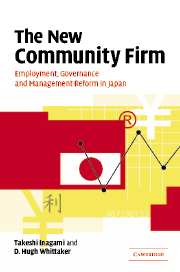Book contents
- Frontmatter
- Contents
- List of figures
- List of tables
- Preface
- Acknowledgements
- Part 1 The End of the Community Firm?
- 1 Company as Community
- 2 The Classic Model: Benchmark for Change
- 3 Change and Continuity
- 4 Company Professionals and Creative Work
- 5 Corporate Governance and Managers' Ideologies
- 6 Consolidated Management and Quasi Internal Labour Markets
- 7 Summing Up
- Part 2 Hitachi: ‘Here, the Future’
- Part 3 The Reformed Model
- Appendix: Changes in Job Tenure
- References
- Index
2 - The Classic Model: Benchmark for Change
Published online by Cambridge University Press: 22 September 2009
- Frontmatter
- Contents
- List of figures
- List of tables
- Preface
- Acknowledgements
- Part 1 The End of the Community Firm?
- 1 Company as Community
- 2 The Classic Model: Benchmark for Change
- 3 Change and Continuity
- 4 Company Professionals and Creative Work
- 5 Corporate Governance and Managers' Ideologies
- 6 Consolidated Management and Quasi Internal Labour Markets
- 7 Summing Up
- Part 2 Hitachi: ‘Here, the Future’
- Part 3 The Reformed Model
- Appendix: Changes in Job Tenure
- References
- Index
Summary
The demise of the community firm and ‘Japanese-style’ employment have been predicted for almost as long as they have been recognized. Consider this observation, written forty years ago:
Technological innovation is necessitating changes in personnel management and there is a change of generation in the workplace … Managerially, it will not be possible to continue with nenko wages which were made possible by the lag between productivity improvements and increases in labour costs; generally speaking Japanese-style employer–employee and union–management relations are headed for a period of fundamental reform.
As many respectable scholars have predicted the end for so long, a certain caution is in order before we, too, join the chorus. We cannot assume, as many do, that a changing environment will automatically spell the end of the community firm. What has changed, and what has not? In order to answer this question, we first need to establish a benchmark.
As we wrote in chapter 1, our three empirical areas of focus will be employment practices, corporate governance and management priorities, or ideology. In addition, we need to look at the boundaries and nature of community membership. In this chapter we will sketch key features or practices associated with the postwar ‘classic model’ of the community firm in these four areas. These will provide a benchmark for evaluating change.
Members, quasi-members and non-members
We start with membership. According to Japan's Commercial Code the company belongs to its shareholders, and they are its members. The common perception is different, however.
- Type
- Chapter
- Information
- The New Community FirmEmployment, Governance and Management Reform in Japan, pp. 19 - 29Publisher: Cambridge University PressPrint publication year: 2005



